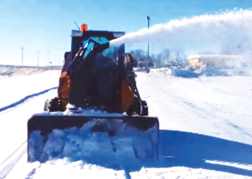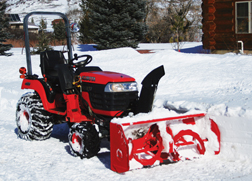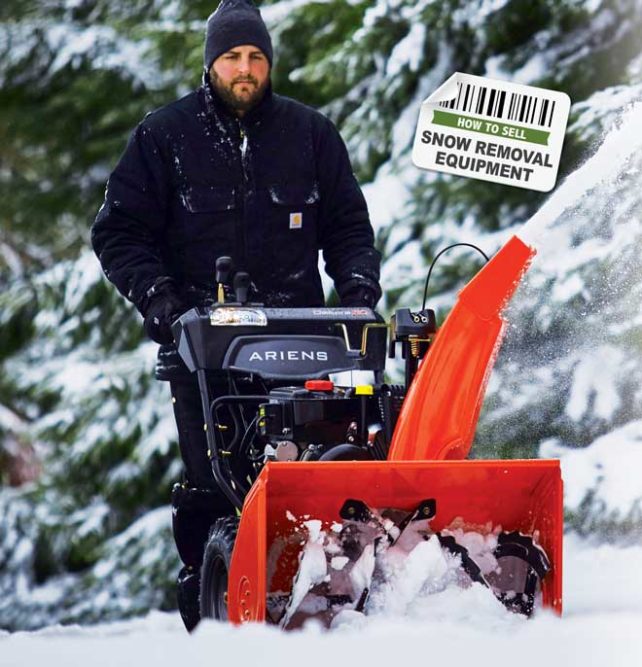Pictured Above: Understand the different areas of a customer’s property to recommend the right equipment. For instance, in tree-lined areas where there isn’t room for banks created by blading, snow blowers may be the preferred method of snow removal. PHOTO COURTESY OF Ariens
If you’re in the right area, selling snow removal equipment can be profitable and provide winter cashflow. Succeeding in the market requires recognizing the preferred method of snow removal in your area; matching your equipment inventory with future snowfall and having technicians willing to repair broken machines during cold weather.
Here’s a variety of success strategies from dealers who sell everything from self-propelled homeowner snow blowers to tractor-mounted blades and throwers to truck mounted blades. See what works for them to see if it can work for you.
Meeting a Variety of Needs
Christa Grywusiewicz of Heartland Kubota, Sheridan, Wyo., has a varied product offering: Hiniker or Meyer plows for trucks; Land Pride and Kubota blades and snow blowers to mount on tractors; and brooms, blades or blowers for Walker mowers.
“Selling snow removal equipment is a good fit for our business in the slower season. The biggest challenge is stocking and ordering. When people think about Wyoming, they think we get mountains of snow, but we’re in a high desert that doesn’t always get that much precipitation,” Grywusiewicz says.
She says it’s easy to tell when the dealership missed predicting sales. “Snowplows on the lot during summer stand out. You base ordering on an average of the last couple of years and your gut feeling. Most of the commercial guys buy heavy ‘V’ plows, but homeowners want a pretty basic plow and exact numbers are tough to call. We can have seasons like last winter when we only sold a couple of plows. We have to order from April through July, so you stare at your cloudy crystal ball wondering what winter’s going to be like. If you don’t order, the manufacturers may be out of stock when a big blizzard hits. Then, you don’t have it and can’t get it, customers are mad and you miss sales.

Commercial snow removal businesses can be excellent customers for equipment. Many prefer renting equipment and in a year with light snowfall, those rental machines may come back with low hours, opening doors to profitable sales of used machines. PHOTO COURTESY OF Art’s Way
“We get a lot of wind so we may shovel the same snow six times. You can move a 6-8 foot snowfall and the next day, the wind has drifted it back, so assisting customers in picking out equipment is a challenge. There’s a lot of variation based on where they live. On a ridge, the wind may blow all the time, but in a valley, they may not get that much wind. A big factor in selecting equipment is the amount of drifting. A lot of our customers are new to the area and have built houses so it may take a season or two to know what they need,” Grywusiewicz says.
Adding Margin in Service
Servicing the product is critical. “When the first big cold snap hits, you feel it. Cold breaks things, so metal and plastic become brittle and after a small impact with a curb, the equipment may be down. Then, you have to schedule your shop time pretty tight to get them back in working order. Plows aren’t technicians’ favorite things to work on, but on the flip side, they know the business is keeping the shop busy in the winter, and that’s crucial to all of our jobs,” she says.
“Snow plow specialists aren’t needed, but a lot of the problems with plows are electrical, so a background in wiring is a plus. Basically, if you’re a good tractor mechanic, you’re usually a good snow plow mechanic. They do generate a good amount of parts business as there are a lot of wear items on a plow including skid shoes and cutting edges,” she says.
Grywusiewicz offers her best advice: “Do really good research on your manufacturers and their support because you have to get parts in short order.”
Dealer Takeaways
Selling snow removal equipment can help winter cashflow, but requires the knowledge of popular types in an area; a supplier with quality products and support; and a willingness to stock and carry over product. Planning inventory can be difficult.
Pre-season sales and service offers can spread out demand, but there is always going to be a glut of business when the first snowfall is forecast.
Being able to provide service for equipment is critical to maintaining a long-term presence in the snow removal business. It’s important to have technicians willing to service machines after hours and in cold weather to keep long-term customers, especially commercial accounts.
Planning Ahead
Mike Halloran owns Halloran Power Equipment in Palatine, Ill. His summer business includes selling lawn equipment from Gravely, Ariens, Scag, Husqvarna and Bob-Cat and in the winter, he sells Ariens and Gravely snow removal products. Halloran worked on a snow crew during his youth and now serves residential and commercial customers.
His location is about 17 miles from Lake Michigan, where up to 85 inches of snow can fall annually in about a dozen events averaging 3-5 inches each, and moving it offers opportunities. “It complements the lawn and garden business. The whole idea is that the customer buys lawn mowers during the summer months, then thinks of us first when shopping for snow blowers. We want them all 12 months of the year,” Halloran says.
“We start displaying snow equipment in the showroom in late summer and there are actually people buying when it’s still 80 degrees outside to beat the rush. Then, it always surprises me that after the first cool night, there are people in the store the next day looking for a snow thrower,” he says.
Halloran says his early sales are generally for premium models. “People who want to be prepared tend to plan better and think things out a little further. Customers coming in the day it snows are reacting to having snow to move, and they may also be reacting to a pocketbook with only $600 in it so they get the smaller model. Eighty percent of the larger machines sell pre-season or after large snow events where customers want the biggest snow blower we have,” he says.
Halloran says the biggest challenge is keeping up in the service department. “At certain times, we have the service guys getting a lot of overtime, burning the candle at both ends, setting up and repairing. The sales end is good, but service is where the real money is. You have your sticker on that machine with your phone number, so when they need service, they’ll call.
“We run our largest snow promotion in August…”
— Brian Coulter, Norfolk Power
“The idea is to get them into a regular service plan where they’re coming in every year for tune-ups, so they don’t have the machine down the day it snows. We have standard tactical pricing for in-season service that’s higher, but offer discounts or free pick-up for pre-season work.
“We try to capture emails from every customer, and that gives us a really cost effective way to send out offers to get ahead of the curve, so they’re not bringing their product in at the first snow,” Halloran says.
He says margins are good on new sales and they aim for 20-25%, which may go down as the season wanes.
Marketing Snow in Summer
Brian Coulter of Norfolk Power in Wrentham and Carver, Mass., and in Burrillville, R.I., sells Ariens, Boss, Toro, Husqvarna, Cub Cadet, Honda, Normand, HLA Attachments, FFC (Paladin Attachments) and SnowEx equipment, along with Kubota and Terex. His area starts getting snow in late December, and normally, customers are moving snow weekly through March. Last year, they sold 2,200 walk-behind snow blowers.
“Ninety percent of your people really don’t want to buy that piece of equipment, especially on the consumer side, until they absolutely need it. So, the first snowfall of the year, we get really busy and it’s a challenge to get all the equipment set up and out the door.
“Typically, our spring demand starts slowing down in June, so we send out service flyers offering discounts to bring the machine in early and get it ready for wintertime. From a sales perspective, we actually run our largest snow promotion during the third week in August and it’s been successful. Those two programs have taken some of the urgency out of the business,” Coulter says.

Homeowners who own tractors may want to invest in front- or rear-mounted snow throwers to avoid service issues related to old fuel in self-propelled models. PHOTO COURTESY OF Heartland Kubota
“This past winter, we had our best snow sales of all time, but with hardly any snowfall. There was so much snow the year before that people couldn’t get their hands on equipment fast enough, so it drove sales for the next year. This year, we anticipate a slower start and to sell less equipment, unless there’s a major snow,” he says.
Coulter also rents to large snow contractors and then sells the returned equipment at a discount. Last year, he rented track loaders out for six months and some returned with less than two hours on them.
Coulter recommends new dealers focus on one or two brands and become proficient at servicing them. “When you’re starting out, you don’t want to pass up any sales, because you want to get every dollar you can. As the business has grown, we’ve found some of our major lines would more than satisfy our business.
“Customers are now used to us being a one-stop shop, but it requires my technicians to know more; my parts department to stock more; and a larger sales staff that needs to know about each piece of equipment. I think as you add lines you start to lose efficiency. You can’t know everything about everything,” he says.
However, you also have to be able to offer service even in bad weather conditions, he adds.
“If it’s snowing outside, it doesn’t matter what day it is, even what holiday it is. We’ve sent guys out in the middle of the night in a blizzard to repair machines. Not every technician is cut out for this type of work, but some actually enjoy it, and we compensate them accordingly. I have an account that hires one of my technicians every storm to sit on their lots and wait for equipment to break. I bill him out at $165 per hour and he gets paid accordingly,” he says.
On the consumer side, Coulter says you need to explain the differences between maintaining lawn and garden equipment vs. snow equipment. For instance, fuel degradation is greater with snow blowers than with lawn mowers because they sit idle during the hottest time of the year.
Focusing on a Single Line
Mike Bookmiller is president of Java Farm Supply Inc., which has stores in North Java, Yorkshire, Batavia and Westfield, N.Y. The area is known for its “lake effect” snows from Lake Erie, and it’s common for the area to start getting snows in mid-December that last through March. While plows are used in his area, the preferred way to move snow is a tractor-mounted blower. This method doesn’t lead to the banks of snow left by other methods and guards against drifting.
Bookmiller focuses on one main snow removal product line, Art’s Way Mfg., which he likes for price and quality. Also, they offer a rear-mount blower, so customers can leave the loader on the tractor and use the loader to drag snow back from buildings or mailboxes. The bulk of his sales go to property owners, but the 10-foot model is used by municipalities and businesses.
His main customer segments include dairy farmers and rural lifestylers, both of whom need to remove larger quantities of snow from longer driveways. “The biggest challenges are definitely stocking the appropriate inventory in the right amounts. Snowfall amounts vary tremendously from year-to-year.
“I always say that if we’re not almost sold out of snow blowers by January, we’ll have them for the next year. After New Year’s Day, people start counting down the days until spring and they try to get by with what they have. You want inventory coming in around mid-to-late September and you start selling then,” Bookmiller says.
“We try to do an average of 3-5 year history of sales and with having four stores now, our market share is growing, so we factor that in and stock appropriately. While it would sound ideal to totally run out at the end of the season, if that happens, you’re losing sales. With 9 widths available and different versions in each model, you can never plan exactly the right amount of each size. If you’re going to totally eliminate paying a little interest, you’re going to eliminate profit and sales because of that. And, you can’t just have one or two sitting out front. You have to look like you’re in the business, because the customer never wants to buy the last one of anything,” Bookmiller says.
Selling a 3-point blower doesn’t generate a lot of parts and service business, so margins are generally made only on the initial sale. Bookmiller likes selling units without engines, eliminating problems associated with old fuel. “On a year when you don’t get too much snow, it will sit in the corner of the shed ready to go for the following year with little maintenance required,” he says.
Bookmiller says there’s a lot of satisfaction in the snow removal business. “I like being able to solve problems for people by offering them a solution when there’s a heavy snowfall and they need to get out and go to work,” he says.






Post a comment
Report Abusive Comment